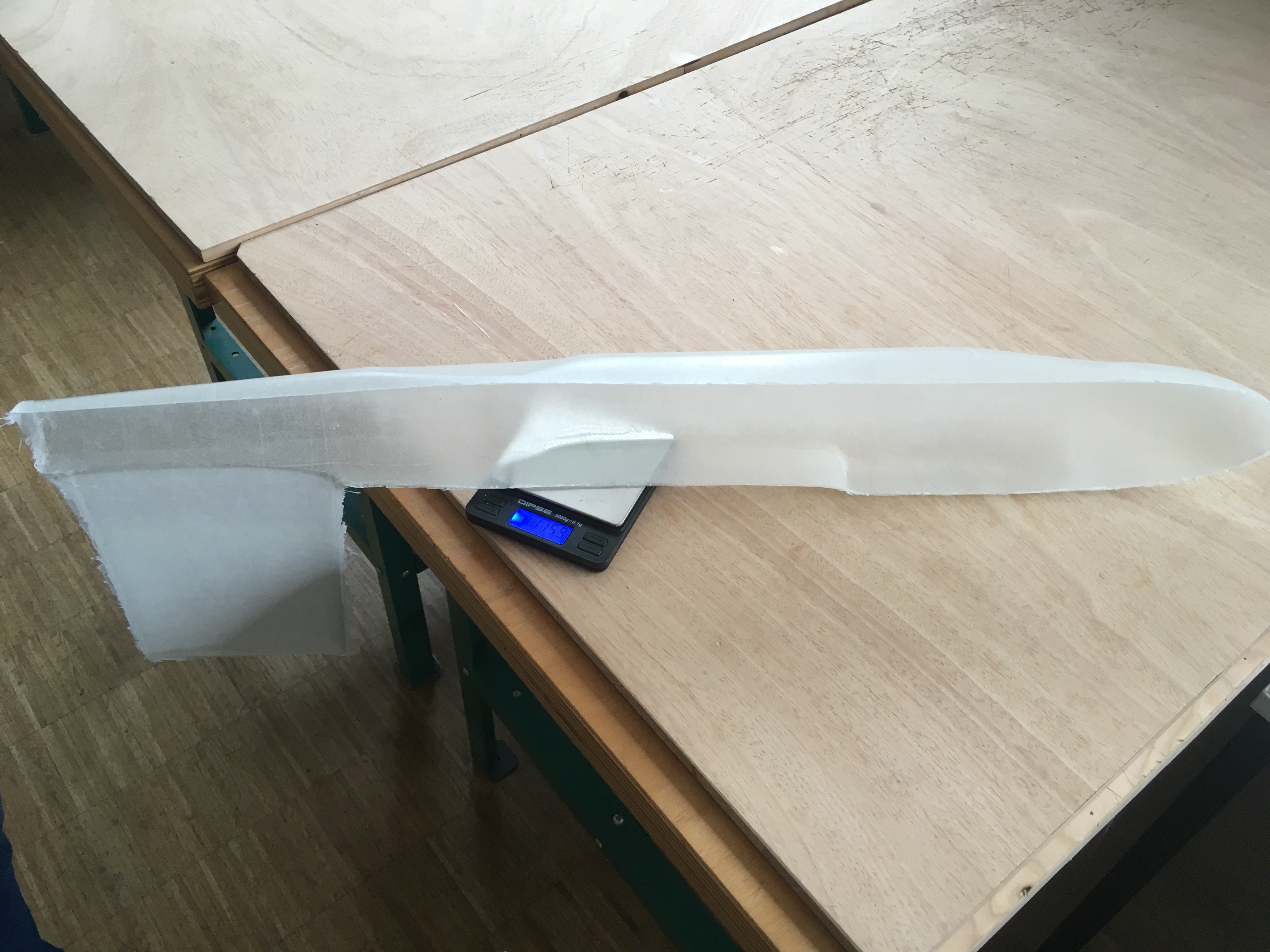Table of Contents
Fiber Fuselage
After still having major problems with waterproof design, the idea is to start a new fuselage design from scratch in fiber composite technology. This promises the following advantages
- Waterproof material - foam is not water resistant
- Possibility to adapt the geometry to our requirements, e.g. camera connection
- Thin material requires only small holes for camera without obstruction view
- Fiberwings will pave the way to possible solar cell support for extending range
The big drawback is missing experience with aircraft design and fiber technology. Further Component tests are here:
As description about the tooling is here:
Strategy
- Design a negative lamination mould from Rampf MB-0600 Polyurethan material by milling
- Mill: Step-Four Xpert 1000 S in the Holzwerkstatt Modellbau
- CAD: Onshape, CAM: Deskproto, NC: XpertMill (Holzwerkstatt)
- Glueing of the Rampf MB-0600 for L shape: Rampf EP2306 resin + EH-2904-1 hardener
- Surface Sealing of the MB-0600 material with Münch Mikon 399 MC sealer
- Release Agent (Trennmittel): Münch Mikon® Mirror Wax liquid W-99+
- Alternative Release Agent: RAKU® TOOL AC-9103
- Laminate 2 layers 160g/m2 GFK (R&G)
- Epoxyresin from R&G
Tooling
The Deskproto CAM software needs some RAM depending on the detail level. The Deskproto Software is installed on the breakout.
Design
Stefan Laimer and Maximilian Schäferle did a first concept design of a fiber fuselage during the Systems Engineering 2 course in WS20/21. This design is used for the first lamination tests. The design is available in "Onshape - Fuselage Shell".
Materials
The membrane supported vacuum infusion tests are done with the material from Composyst in Landsberg. The other tests with hand lamination and vacuum pressure are done with material from R&G.
Vacuum Pressure Materials
Neu für Flügel:
Membrane Supported Vacuum Infusion Process (Composyst) Materials
- Lochfolie, Fließhilfen, Aluröhrchen, 8mm Schlauch u.s.w.
Gewebebänder, Mumpe und Gelcoat
- R&G Glasgewebeband 130 g/m² (Silan, Leinwand) 25 mm - 200115 und weitere Glasgewebebänder 130g/m2 40mm, 225g/m2 20mm, 225g/m2 40mm
Anschlüsse, Schläuche
- PVC Schlauch ID 8mm
Kleber
GFK Platten
First milling
On 15./19./20.12.2020 we did a first milling test with a small MB-0600 test block
- Testblock size: 250mm x 146mm x 75mm
- CAD: Onshape - FräsenTest
The milling was done aiming at best milling results. So the distance between milling paths and z distance was set to 0.06mm. Schlichten took 2h 50min for the “Z Konstant” strategy and 7h for the “Überkreuz” strategy.
(Friedrich Beckmann, 23.12.2020)
First Lamination Test
Some initial lamination test with the “Minirumpf” with 2 x 160g/m2 glas fiber with vakuum showed laminates which seem optically o.k. but the laminate is not waterproof. I made three tests with different amounts of resin in the mould. The final weight after the vakuum process is however always more or less equal. The area of the “Minirumpf” is about 3dm with a laminate weight of 21g.
On 4.3.2021 Alex, Björn and I did a lamination test of the 80cm fuselage half.
- Surface Sealing of the MB-0600 material with Münch Mikon 399 MC sealer
- 2 x Release Agent (Trennmittel): Münch Mikon® Mirror Wax liquid W-99+ (1 month waiting time)
- R&G Resin L with EP161 Hardener
- First layer of pure resin with brush
- 1 x 49g/m2 glas fiber (brush)
- 3 x 160g/m2 glas fiber (brush)
- Abreißgewebe (brush)
- Lochfolie
- Saugvließ
- Vakuumsack at -900mBar for 24h
- Removal of the laminate from the mould after another 24h
Results
The laminate is not waterproof. After about 10 seconds water penetrates through an optically o.k. laminate.
There must still be air/voids in the laminate although it seems optically in good condition. The fuselage half has a weight of 116g.
Ideas
A flat test laminate without vacuum shows a closed surface and a simple water test did not show easy water penetration. I think we must find a way to avoid the voids/air in the laminate. I am pretty sure that the voids also have an impact on the strength of the laminate but nothing is tested on that side. So to improve water resistance I have the following ideas:
- Add an epoxy gelcoat layer. Yachts and gliders have a Gelcoat finishing layer but most model planes do not have that. This will hopefully provide a closed watertight surface layer.
- Hand lamination without vacuum. The hand lamination will have more resin in the laminate and the surface seems closed. No idea if the voids are reduced or if there is just a closed surface.
- Vacuum infusion. Compared to vacuum bagging literature claims that voids are reduced with this technique. The VAP membrane technology might be a way. This promises a void free laminate with a high fiber content.
- Degassing the resin. Is probably useless for hand lamination because bubbles are introduced during the lamination process.
(Friedrich Beckmann, 7.3.2021)
Membrane supported Vacuum Infusion (Composyst)
A first lamination test with membrane supported vacuum infusion technology was done at Composyst in Landsberg on 19.3.2021. The results are very promising. I have made a video to show the differences between vacuum compression and membrane assisted vacuum infusion technology. (TODO: Describe the process).
Friedrich Beckmann (1.8.2021).
